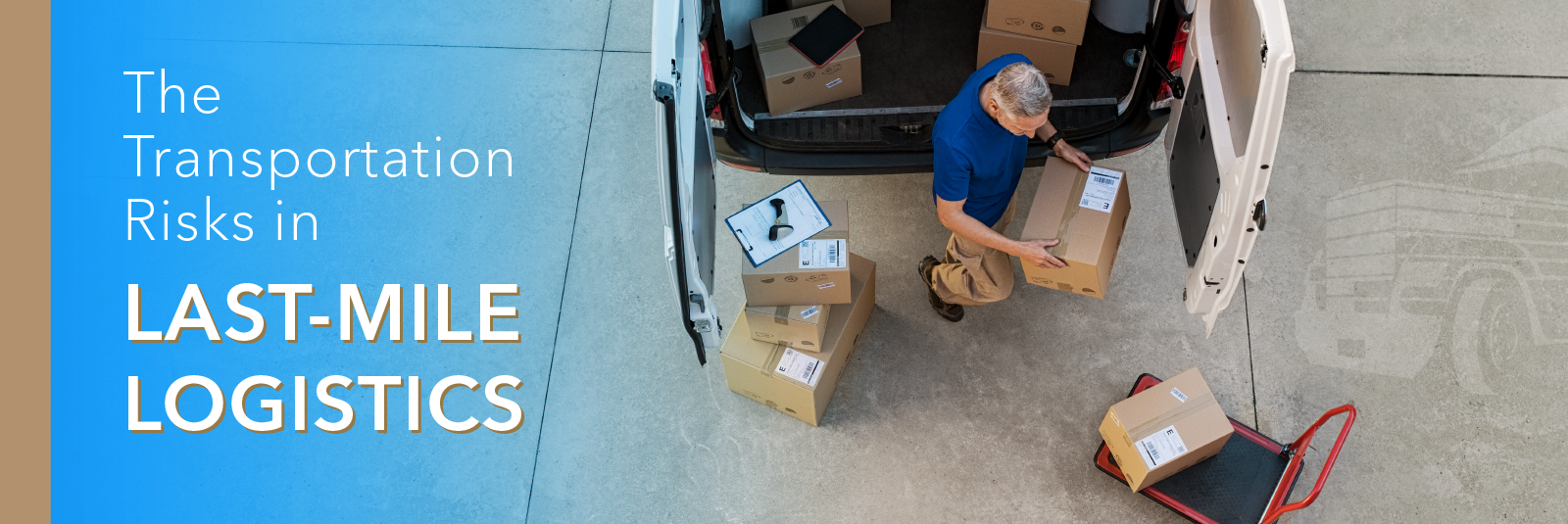Now more than ever, consumers expect retail companies to fulfill their orders and deliver their packages quickly and efficiently. And in the consumer’s mind, there’s no room for delays or mistakes. They want their orders, and they want them now.
For companies to comply with consumer expectations, they must focus on fine-tuning their last-mile logistics. You see, the last mile is a critical part of any transportation strategy, and the competition is fierce among companies providing this service. The only way to compete without opening your business up to liability is to fully understand the risks at play in last-mile logistics.
The Long Last Mile
Last-mile logistics is the final “leg” of the shipping process where products are delivered to the customer or end-user. This segment isn’t actually a mile — it could be one block or 100 miles. Regardless of the distance, what’s consistent is the increasing consumer demand for quicker deliveries and better customer service. And even in a global pandemic, there’s no sign of it slowing down. Economic forecasts predict that e-commerce sales will increase by 13.7% in 2021, hitting $908.73 billion.
Last Mile Transportation Risks
The last mile counts for an estimated 50% of total logistics cost. That cost fuels a lot of moving parts and complexities, ultimately resulting in shipments reaching consumers’ doorsteps. The devil’s in the details and there are challenges and risks unique to last-mile transportation:
- Warehouses
Efficient last-mile logistics requires inventory to be close at hand. In other words, the current e-commerce environment demands more warehouses to be as close as possible to the densest customer concentrations. Inside the facilities, there must be clear processes to ensure speedy selection of the correct items, and proper address labeling.
If warehouses are too spread out or gaps exist in internal systems to find and deploy the right products, there is significant risk to delivery timelines and customer satisfaction. Not to mention, in 2021, we’re seeing a massive shortage of warehouse workers, as many have joined the Great Resignation wave during the pandemic. Understaffed warehouses mean there are not enough workers to unload trucks, sort through orders, and deliver items, which translates to major delays and disruptions in the process.
- Urban Areas
Crowded cities pose their own set of risks to effective last-mile logistics. Traffic congestion, insecure destinations where theft of the shipment is likely, and inaccessible destinations (for example, gated buildings or out-of-service elevators) all are challenges in urban environments. Shippers and 3PLs must know how to navigate these risks in order to avoid delays or losses.
- Suburban or Remote Areas
Suburban and remote areas can also be difficult to access, but for separate reasons. Greater distances from warehouses or distribution centers and hard-to-locate destinations pose a risk to disrupting last-mile logistics.
- Consumers
Consumers can negatively impact the last mile, as well. If recipients aren’t present to sign for deliveries, addresses are incorrect, or recipients experience buyer’s remorse, shipments will “reverse.” Cost accrues by sending products back through the supply chain, which opens the door to more risk of loss and liability.
- Supply Chain Disruptions
If 2021 has taught us anything, it’s how much we rely on a secure and steady supply chain. Due to the chaos of the pandemic, we’ve experienced firsthand the trickle-down effects of the current supply chain crisis as the shipping industry grapples with port congestion, labor and material shortages, and major price hikes.
All of these factors can significantly impact the last-mile logistics, such as whether the inventory is even available and how long it will take to reach this last stage in the delivery process. This holiday shipping season, in particular, will be very telling in the ways the supply chain can—and will—disrupt the last mile.
- Price Increases
The cost of fuel accounts for 10% to 25% of last-minute delivery costs. And now shippers need to consider rising fuel costs. In September 2021 alone, fuel prices surged an average of 35%.
But shippers also need to take into account the high price of labor (particularly due to staff shortages), transportation software, failed deliveries, and more. This impacts how much the shipper pays to orchestrate the last stretch and what the consumer pays for that service. The more it costs the shipper, the more it’s going to cost the consumer.
Protecting Against Last-Mile Liabilities
Although companies face unprecedented challenges, especially due to the global pandemic, they are focused on improving last-mile logistics. They are turning to new technologies and tactics like drones, delivery lockers, sharing economy business models, image-based data capture devices, and sophisticated transportation management systems. These solutions will improve last-mile logistics and consequently reduce the inherent risks, but 3PLs will always need to take steps to limit their liability.
Falvey Shippers can help clients understand, manage, and limit the risks associated with last-mile logistics as this sector continues to grow and evolve. Contact us today to find out more.

